If you’ve been on the hunt for effective, natural solutions to boost the health and vitality of your hair, you’ve likely come across the buzz surrounding apple cider vinegar for hair in various beauty circles. But you might also be wondering if this kitchen staple is truly worth the hype; what specific benefits does it offer for those seeking to enhance their hair’s appearance and strength and how to actually prepare and apply ACV rinse at home? In this article, we explore the science behind using apple cider vinegar on hair, guide you on how to best harness its potential, and shed light on the tangible benefits it can bring to your hair care ritual and hair routine.
What is apple cider vinegar?
Vinegar comes from the French phrase “vin aigre,” which means sour wine. It can be made from nearly anything containing sugar, including fruit, vegetables and grains. Yeasts first ferment sugar into alcohol, which is then turned into acetic acid by bacteria. The industry makes apple cider vinegar from fermented apple juice. Apples are crushed for the juice, following by the addition of bacteria and yeast. This starts the alcoholic fermentation process, which converts the sugars to alcohol. In the second fermentation step, the alcohol is converted into vinegar by acetic acid-forming bacteria (Acetobacter species). Acetic acid is necessary to make vinegar mildly acidic, with a typical pH of 2–3.
(For reference, the pH scale ranges from 0–14:
- 0.0–6.9 is acidic
- 7.0 is neutral
- 7.1–14.0 is alkaline (also known as basic)
The human body is slightly alkaline with a pH between 7.35 and 7.45, while human skin is on average just below 5.
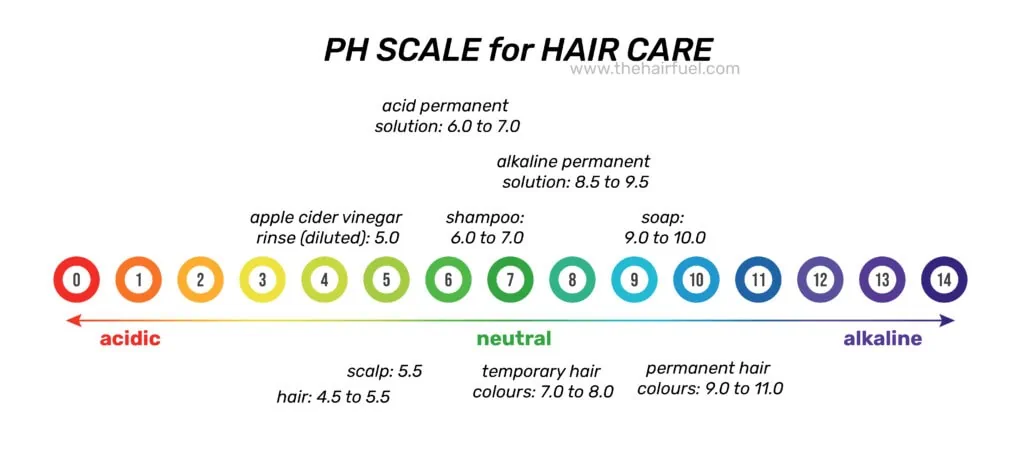
Acid mantle – an invisible helper
Relatively recently, scientists discovered Stratum corneum or “acid mantle” on the outermost layer of human hair and skin. It is mildly acidic 4.5-5.3 increasing by a few points in its lower layers. Majority of shampoos are alkaline, stripping natural hair oils that maintain delicate pH balance in your hair resulting in dullness, dryness and brittleness. Shampoos containing SLS (sodium lauryl sulfate) with alkalinity reaching as high as 11-12 are the biggest offenders.
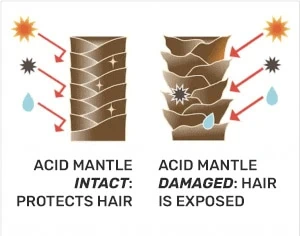
The acid mantle is critical to our hair’s appearance, because it contributes to the shine and tactile feel of the hair. The outer layer of the hair shaft, also known as the cuticle, is comprised of tightly packed overlapping scales. The acid mantle is instrumental in making cuticle scales lie flat, which gives hair a shiny, smooth appearance, and protects from moisture loss.
Alkaline products disturb and even destroy the acid mantle, leading hair cuticles to “stand up” like bottle brush. Such vulnerable hair structure makes the hair fragile due to moisture loss, increasing its brittleness and loss of shine.
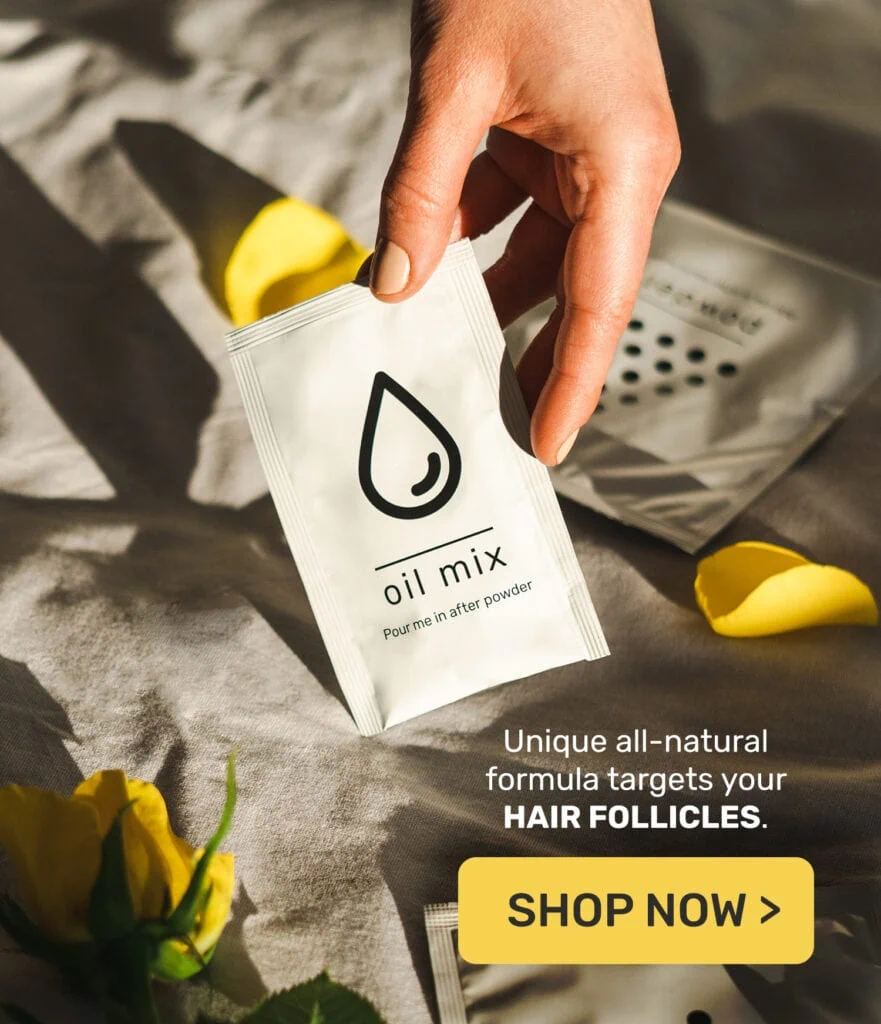
By now you should be convinced that in order to maintain shiny and healthy-looking hair you need to avoid harsh shampoos in order to maintain the balance of your acid mantle. This is where apple cider vinegar comes in. Mildly acidic, it balances out the alkalinity from harsh shampoos and hard water commonly flowing from taps of urban environments cities – making sure that the cuticles of your hair lie flat and retain moisture well.
Why apple cider vinegar rinse is good for hair?
Contrary to a common misconception, apple cider vinegar isn’t “packed” with nutrients. It does have some potassium and traces of iron and magnesium: thanks to being made from apples naturally rich in those elements. Higher quality cider vinegar has amino acids and antioxidants good for your scalp health.
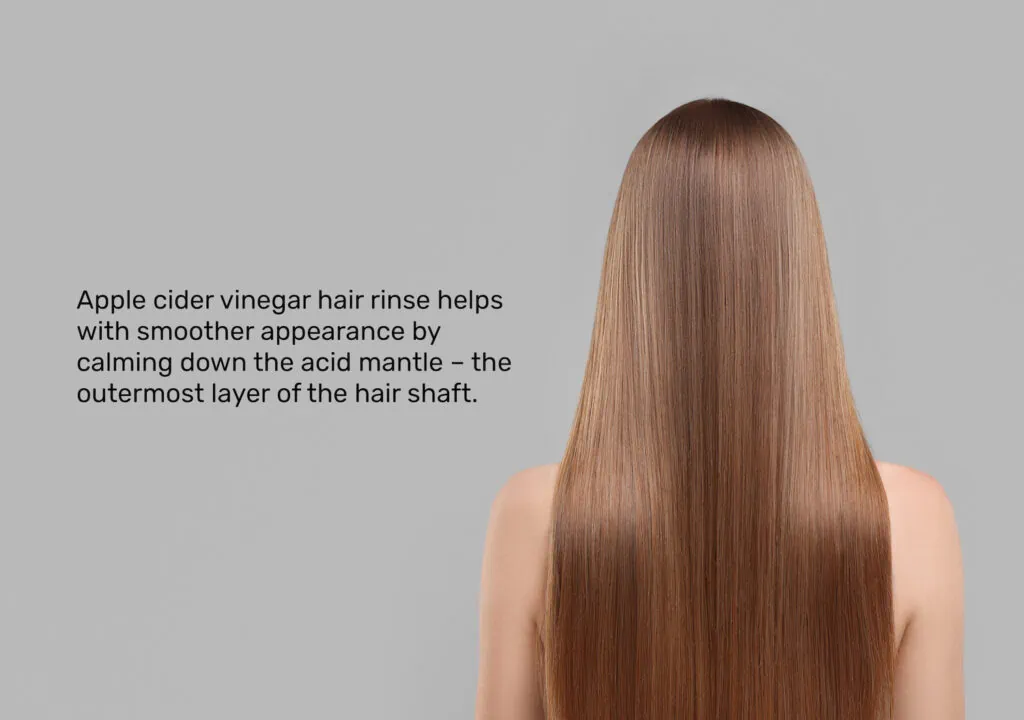
However, while not a high nutritional value provider, ACV delivers the benefits as an acidity regulator. Because of being mildly acidic, apple cider vinegar restores the natural pH of the acid mantle of your hair. Exposure to this acidity calms the outer layer of the hair, flattening the cuticle, which results in hair that shines and slides easily, making it less prone to tangling, snagging and therefore – reducing hair frizz.
For those who experience other scalp conditions, for example, dandruff – apple cider vinegar can bring relief due to its anti-viral, anti-fungal, and anti-bacterial properties. In addition to being antimicrobial, apple cider vinegar is also anti-inflammatory agent, which can counteract the skin inflammation that typically precedes dandruff and a dry, flaky scalp.
Clarifying properties
Apple cider vinegar, due to presence of acetic acid, can help removing product build up. Think about all those home hacks that recommend using vinegar to remove limescale and dirt. Though a diluted ACV hair rinse is a gentler option, the mechanism of removing product build-up from your hair is similar. Product build-up is a direct result from using silicone-based products in your hair care routine.
Easy recipe for ACV hair rinse
Mix 1/2 to 4 tablespoons (5-60ml) of good quality ACV with a large glass of water (8 ounces / 250ml) in a plastic squeeze bottle, spray bottle or other container.
(We recommend starting with low concentration of the ACV to water ratio and then observing how your hair feels, one hair wash day at a time. Experiment to find a proportion that works best for your hair type and scalp and get curious about it. As a rule of thumb, dry hair likes less ACV and oily hair like more.)
- After shampooing and conditioning, pour the mixture over your hair evenly, working into your scalp and gently squeezing into your hair lengths.
- Let it sit for 2-4 minutes.
- Rinse it out.
You can add a couple of drops of your favourite essential oil, we recommend peppermint oil – to help mask vinegar smell. However, even if you don’t add it, it tends to disappear quickly as the hair dries.
Can apple cider vinegar hair rinse be bad for you?
Yes, there are several reasons why apple cider vinegar may not be suitable for your hair, and it’s important to be aware of these potential drawbacks and risks:
1. Dilution errors
One of the most common mistakes when using ACV on hair is not diluting it properly. Applying undiluted ACV can be too harsh for your hair and scalp, potentially leading to irritation, dryness of the hair and scalp, and damage. Solution to this is to ensure you dilute ACV with water before use in the correct proportions (read them here >).
2. Scalp irritation
If you have have a sensitive scalp, the acidity of ACV can lead to irritation, itching, or even burning sensations. If you have a history of scalp sensitivity or skin conditions, it’s best to do a patch test before applying ACV to your entire scalp.
Patch test for apple cider vinegar hair rinse
To do a patch test for an apple cider vinegar (ACV) rinse on your hair, apply a small amount of diluted ACV in accordance to your chosen proportion to a discreet area of your scalp or behind your ear. Leave it for a few minutes, then rinse thoroughly. Check for any signs of irritation, redness, itching, or discomfort before using it on your entire scalp.
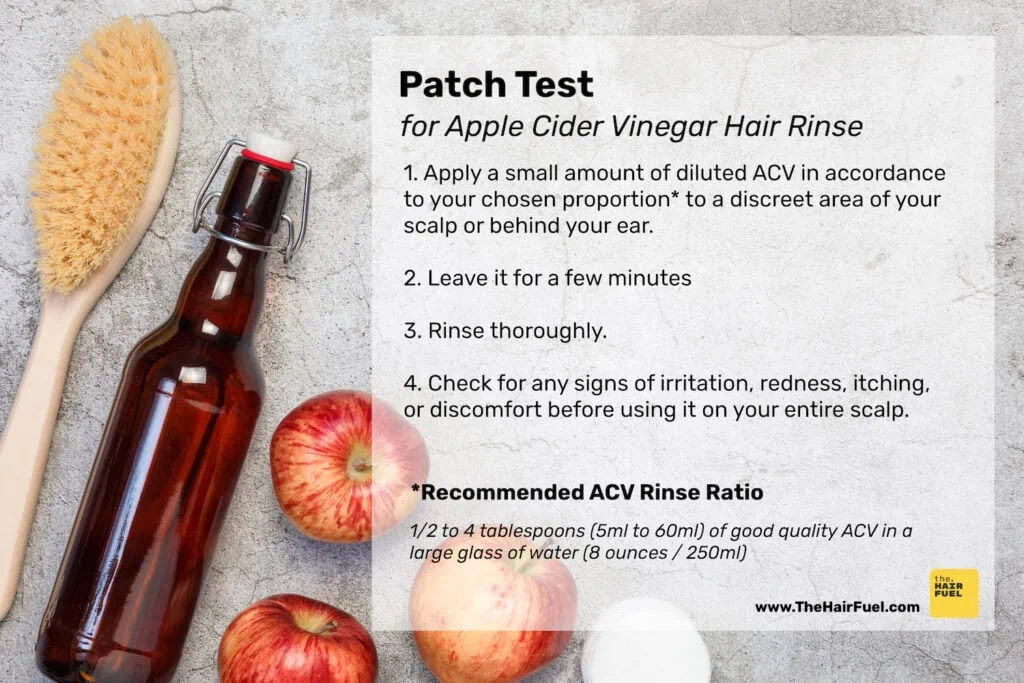
3. Dryness from ACV hair rinse
While ACV can help balance the pH of your scalp, excessive or frequent use can lead to dryness, especially if you already have dry or damaged hair. Apple cider vinegar is acidic in nature and especially when not diluted in the correct proportions, it may strip your hair of its natural oils, leaving it brittle and prone to breakage. Remember that your hair needs its natural oil to maintain its lustre and shine.
Read more: how to oil your hair >>
4. Allergies and sensitivities
Some people may have allergies or sensitivities to ACV. So using it on your hair could lead to adverse reactions. If you’re unsure how your skin and hair will react, perform a patch test described above.
5. Hair type consideration
ACV might not be suitable for all hair types. While it can be helpful for oily hair or hair with product build-up, it may not provide the same benefits for dry or curly hair types.
- Curly hair tends to be more dry than straight hair. The oil which your scalp produces needs to travel a more “long-winded”, curly-curvy road – and therefore struggles to cover the full length of the hair strand. This results in curly hair in general being more dry than straight hair.
- The acidity in the vinegar can destroy the thin layer of natural hair oil around a hair that’s already dry, for example – dry hair as a result of menopause or a thyroid condition, therefore worsening the dryness of your hair – leading to more brittleness and breakage.

6. Strong smell of vinegar
The smell of ACV can be unpleasant to some people, and it might linger on your hair until it dries. If you are sensitive to strong smells, this could be a significant drawback for you to consider. As a way to counteract this, you can add a few drops of your favourite essential oil to the rinse.
7. Effect on hair colour
ACV may affect hair colour, especially for those with dyed or chemically treated hair. It could potentially cause colour fading or alteration, so be cautious if you have color-treated hair.
In some cases ACV hair rinse can lead to actually securing the hair colour, but in some – may cause a fading effect. Therefore, doing a patch test is a good idea.
8. Overuse of apple cider vinegar hair rinse
Using ACV too frequently can lead to over-processing of your hair, as it is an acidic substance. It’s important to find the right balance and avoid using it too often. If the product build up is the main reason for you to use ACV regularly, consider using hair care products that cause minimal to no product build-up. For example, swapping your conditioner with dimethicone (non-water soluble silicone) to a conditioner with either a water soluble silicones or no silicones, instead.
Read more about silicones in hair care here >
9. Health conditions
If you have specific scalp or health conditions, such as eczema or psoriasis, ACV may make these conditions worse. Consult a healthcare professional or dermatologist before using ACV on your hair if you have underlying health issues.
10. It just doesn’t work for you
If you see a TikTok about how amazing apple cider vinegar was for someone else’s hair, don’t feel disappointed for too long if you used all the right proportions, but it didn’t work for you. ACV like any other hair product or DIY rinse, may not produce equal or desired results for everyone. What works well for one person may not work the same way for another, so some people may not see any significant benefits from using ACV on their hair.
If you decide to use ACV for your hair, it’s crucial to follow the recommended dilution ratios, monitor and learn from your hair’s response, and adjust your proportions and frequency of usage, as needed. If you experience any adverse effects or concerns, stop using it and consult a dermatologist or a professional hair specialist for guidance to address your specific hair care needs.
Sources:
Natural skin surface pH is on average below 5, which is beneficial for its resident flora, (1)
Stratum corneum pH: Formation and Function of the ‘Acid Mantle’ (2)

Who we are:
The Hair Fuel is an all-natural hair growth mask created by Laura Sagen, who lost a third of her hair after a terrible visit to a hairdresser while suffering from a life-long condition of PCOS associated with androgenic hair thinning. She developed the formulation rooted in the science of scalp blood flow, which has become The Hair Fuel growth mask. Since then, her company has helped thousands of people like you to start growing healthy hair.
We work closely with our lab and manufacturers to ensure the highest quality product. But a product alone is never enough – so we hold your hand throughout your own, unique hair growth journey. Our flagship product, The Hair Fuel mask coupled with tailored advice, digital tools, and online support is there to help you grow the best hair you can. It’s a big claim – but we’re unafraid to make it. Check out our starter bundles >>

I’ve been testing a lot of ACV Rinse recipes recently. Just one question.
How often should I use it?
You should use it once in two-three weeks, depending how much product build up you experience. At the very most you can use the rinse every week, but not more often than that since overuse can lead to dryness. To mention also, that in order to prevent product build up – consider switching to natural shampoos / hair care – here is a post about that: https://www.thehairfuel.com/silicones-in-hair-care-all-you-need-to-know/
Good luck! x
Wow! Thank you so much for the comprehensive post. I have always heard that apple cider vinegar can help my hair health in many ways but I kept doubting it because I can’t ex[lain how. So I decided to do some searches. And it was really worth it. You have just made everything simple to me,
Now, I can consider adding it to my hair routine treatment.
Thank you so much.
You’re welcome! Glad you found this helpful. Good idea to use it regularly, but no more than once or twice a month, as otherwise hair can become brittle. Definitely worth it – especially that it’s so cheap, too 🙂
Does usage of apple cidar vinegar causes graying of beard or head hair????
Hey Amit! Reduction in melanocytes’ activity in your scalp is what causes graying of the hair. Once melanocytes stop producing pigment which gives hair its colour, it turns gray. The key is to focus on supporting the lifecycle of melanocytes – which means focusing on scalp and hair root, rather than the hair shaft (which is what ACV mostly does). And it goes both ways, applying something to the length of your hair wouldn’t affect the melanocyte function. Hope this helps!
I have dry patches of skin on my scalp that flake off when I brush my hair, will ACV help and how often should I use it
Hey Joshua, we would suggest seeing a dermatologist before trying ACV to understand the reason for flaky scalp first. Because the rinse does dry your hair strands if used too often that can lead to hair breakage, we would not recommned it more often than 2-3 times a month.